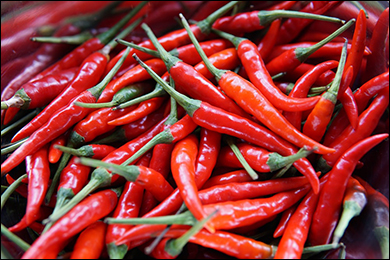What are the Health Benefits of Cayenne Pepper (Capsicum annuum)?

Introduction
India is the world’s largest producer, consumer and exporter of chilli Chili peppers. There are more than 400 varieties of chilly available all over the world. The different varieties and stages of maturity have a great effect on their pungency, shape, size and colour. It is the third most important crop of the Solanaceae family (after tomato and potato.
- Kingdom – Plantae
- Family – Solanaceae
- Botanical Name – Capsicum annuum
- Common Name – Red chilly, bell pepper
- Hindi Name – Lal mirchi
- Sanskrit Names – Katuveera, Raktamaricha, Pittakarini
Morphology
This plant is native of Brazil. It is a small herb and grows up to a height of 2-3 feet. It is found and cultivated in the temperate areas of India. It has white coloured flowers. The fruits are green when unripe and becomes red after ripening. The seeds are pungent in nature.
What are the Chemical Constituents of Capsicum annuum?
Red chilly contains capsaicin, capsorubin, rubixanthi carotenoids, flavonoids, steroidal saponins etc. The capsaicin stimulates the circulation and alters the temperature regulation, therefore desensitizes the nerve endings and acts as a local analgesic.
The Vitamin A and C content in chilli pepper is 6 times more than an orange fruit. It is also a rich source of other vitamins such as Vitamin B2, B6, E, riboflavin, niacin and folate. It is also a good source of potassium, iron, magnesium, manganese as well as macro-nutrients.
It also contains essential amino acids tryptophan, lysine and phenylalanine that cannot be synthesized in the human body
The powder of cayenne pepper or red chilly is used as a spice in many cuisines all over the world.
Ayurvedic Properties of Cayenne Pepper
- Rasa (Taste) – Katu (Pungent)
- Guna (Qualities) – Laghu (light to digest) and Rooksha (dry), teekshana (strong)
- Vipaka (taste conversion after digestion) – Katu (pungent)
- Veerya (Potency) – Ushna (Hot)
- Part Used – Fruit
- Effect on Tridosha – Reduces vitiated Kapha and Vata dosha and increases Pitta dosha.
- Dosage – 30-60 mg
What are the Health Benefits of Cayenne Pepper?
1. Natural Pain Killer
Capsaicin is the active ingredient of Cayenne pepper responsible for its strong analgesic property.
- Therefore, it is useful in osteo-arthritic pain and beneficial in headaches, including migraine Cluster Headaches.
- It is also useful in treating the pain associated with cancer.
- It is one of the most powerful local pain relievers and useful in treating surgery scars, shingles etc.
2. Useful in Cardiovascular Disorders
Capsicum annuum reduces the blood cholesterol and triglyceride levels as it prevents the deposition of fats along the blood vessel walls.
- It also lowers the heart rate and blood pressure.
- Therefore, it can reduce the incidence of cardiovascular disorders by the inhibition of platelet aggregation and the activity of clotting factors.
3. Improves Oral Health
It is useful in oral diseases such as (periodontitis), gingivitis etc. due to its anti-inflammatory properties.
- Cayenne pepper is also useful in bleeding gums, toothache, swollen gums, dry mouth etc.
4. Supports Detoxification
Cayenne pepper is helpful in the detoxification of the body because of its circulatory stimulant property.
- It can raise the temperature of the body and kick-start the metabolism for streamlining the body’s natural detoxification process.
- It also activates the sweat gland which is a crucial factor for the detoxification of the body.
5. Improves Symptoms of Psoriasis
The topical application of capsaicin is very useful in the treatment of psoriasis.
- Its anti-oxidant and anti-inflammatory properties help in reducing itching and other symptoms of psoriasis significantly.
- Moreover, due to its anti-microbial property, it is helpful in preventing infections.
6. Immunity Booster and enhances (Insulin Sensitivity)
Cayenne pepper contains high amounts of beta-carotene, Vitamin C and Vitamin A which help in building the immune system of our body.
- Its active ingredient Capsaicin boosts the defense mechanism of the body.
- The presence of carotenoids, anti-oxidants and Vitamin C are useful for regulating the insulin. Vitamin C decreases the chronic inflammation by combating free radicals.
How to Use Cayenne Pepper at Home?
- To treat headache, the paste of the fruit mixed with sandalwood powder can be applied on the forehead.
- To relieve sore throat or improve voice, the powder of bell pepper should be mixed with honey or sugar and can be taken in the dose of 3-5 gm.
- In cholera, small pills prepared from the powder of bell pepper along with asafoetida and camphor can be given along with the treatment.
- For heart patients, regular intake of small quantity of red chilly along with food as a spice is recommended as it prevents clotting of blood.
- For pain and sprain, application of red chilly along with castor oil is very effective.
- In numbness, mustard oil mixed with red chillies may be applied.
Adverse Effect of Cayenne Pepper
The excessive intake of red chilly can cause hyperacidity, ulcers in the stomach, oral cavity etc.



